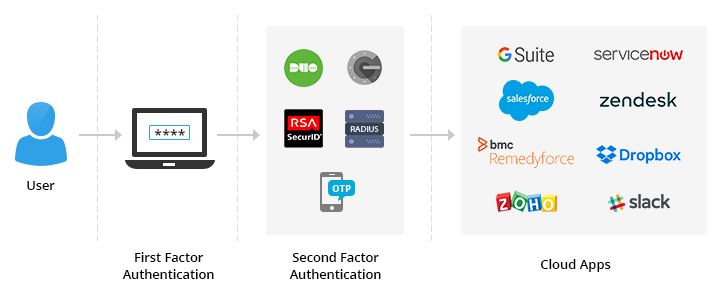Want secure access to Windows logons and multiple cloud apps? ADSelfService Plus is a two for one

Enterprise applications have become an integral part of a tech user's life. Although the utility and user experience of these applications has been getting better, the risk of cyber attacks has also been on the rise. That's why it's important to provide employees with secure access to enterprise applications without hampering the user experience. That's why we've compiled an expert's guide on combining TFA and SSO.
Problems with passwords
For a while now, passwords have been the first and often the only line of defense when it comes to cybersecurity. With cyber attacks on the rise, using only a password for authentication is no longer sufficient. To add on to outside threats, many users reuse passwords across several applications, leaving them open to multiple avenues of attack.
Two-factor authentication
One way to mitigate the vulnerability of using just a password is to add another layer of security. Including an extra layer—also known as a factor—should be sufficient enough to prevent most cyber attacks that leverage or bypass passwords. Most two-factor authentication (TFA) methods verify a user by combining something they know, like their username and password, with some they have or receive, like a one-time password (OTP) through SMS or email.
The right way to implement TFA
Although implementing TFA enhances security, the user experience often takes a hit when a user has to frequently access multiple TFA-enabled applications. For enterprises, using TFA for too many apps is bound to be counterproductive, as it forces users to go through an extended authentication process for every application they want to access
So what's a better way to implement TFA? Well, ADSelfSerivce Plus provides users with seamless access to multiple applications at once with just a single sign-on.
How TFA in ADSelfService Plus is done
 Two-factor authentication for enterprise applications
Two-factor authentication for enterprise applicationsADSelfService Plus supports service provider-initiated single sign-on for many popular applications like G Suite, Salesforce, and Office 365. When a configured user tries to directly access an application that's been configured in ADSelfService Plus, the user will be automatically redirected to ADSelfService Plus' authentication screen.
Once a user's credentials are verified, that user receives a verification code through one of the factors configured by the administrator. After completing both forms of authentication, a user can then access all the cloud applications configured for them.
Getting TFA right
ADSelfService Plus even supports TFA for Windows logon through popular authentication methods, like:
Duo Security
RSA SecurID
RADIUS
SMS and email-based verification codes